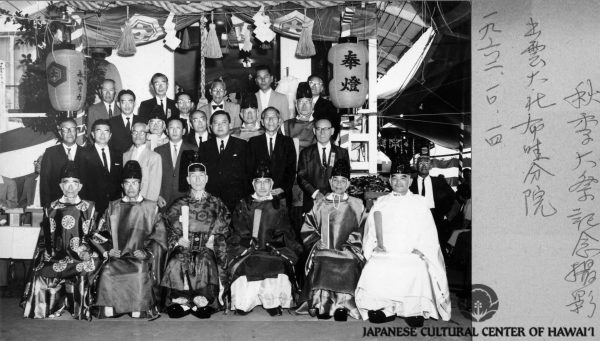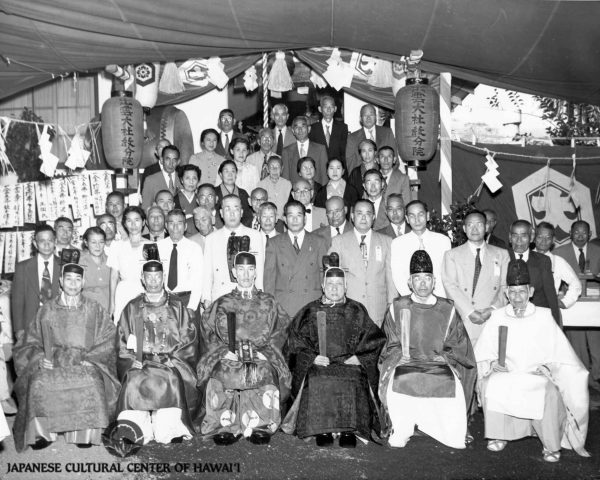Group Media & Photos

Izumo Taisha Fall Festival, October 1962. Row 1 (L-R): Rev. Shigemaru Miyao (3rd), Rev. Shigeo Fujino (4th), Masayuki Chikuma (6th). Row 2: Soichi Obata (1st), Senator-Elect Daniel Inouye (5th), Kaoru Oota (6th). Row 3: Matsujiro Otani (L of Inouye). Back Row: Yoshio Koike (2nd). JCCH/ Nancy M. Fujino Collection.

Shinto priests and supporters, Izumo Taisha Kyobuin. Row 1: Rev. Shigemaru Miyao (3rd from left). Row 2 (L-R): Koichi Iida (5th, white suit); Kumaji Furuya (6th), Taichi Sato (8th). JCCH/ Ken French Collection.
Internment Locations
Arrested: December 1941
Sand Island Internment Camp, Honolulu, Oahu Island
A group of 172 Hawaii men (mostly Issei) were sent aboard the military transport ship USS U.S. Grant for internment in U.S. Army and Department of Justice camps on the Mainland. Together, the men were sent from camp to camp.
In June 1943, this transfer group was split into two, with this group sent directly from Camp Livingston to the Santa Fe Camp.
From there, some internees were paroled to War Relocation Authority camps, where they were reunited with family members. Others were transferred for repatriation to Japan.
Angel Island Detention Facility, California
March 1942
Camp McCoy Internment Camp, Wisconsin
March 1942 - May 1942
Camp Forrest Internment Camp, Tennessee
May 1942 - June 1942
Camp Livingston Internment Camp, Louisiana
June 1942 - September 1942
Seagoville Internment Camp, Texas
September 1942 - May 1943
Crystal City Family Internment Camp, Texas
May 1943 - December 1945
Returned to Hawaii: December 1945
Arrived in Honolulu with about 775 other internees aboard the military troopship the Shawnee.
As head priest at the Izumo Taisha Shinto Shrine in Honolulu, Shigemaru Miyao was arrested along his wife, Yuki, shortly after the bombing of Pearl Harbor. Yuki Miyao, it is believed, was mistaken for the priest's widowed step-mother, Yoshie Miyao, herself a priest at the Shinto mission.
The imprisonment of the Miyaos left their three young children to be cared for by relatives of grandmother Yoshie, the Inokuchi family of Waipahu. In time, the Inokuchi family head, Kakuji Inokuchi, would also be arrested and sent to the Honouliuli Internment Camp. In August 1942, the Miyao children joined a group of internee wives and children transiting the U.S. Mainland and were reunited with their parents in the Crystal City Camp in Texas.
In Hawaii, with the Miyaos in captivity and the fate of the Shinto mission uncertain, congregation members sold Izumo Taisha's property and shrine in 1944 for $2,400 to the city of Honolulu in a display, it has been said, of wartime patriotism. Upon his return from internment, Shigemaru Miyao embarked on efforts to regain the mission property and shrine. What followed were years of legal wrangling until 1961, when a Honolulu court ruled in favor of Izumo Taisha. The mission moved its headquarters to its present site near the Nuuanu Stream and renovated its original, hand-built shrine, which had been designed by Big Island architect (and later internee) Hego Fuchino.
Bishop Shigemaru Miyao died in 1993, having led the Izumo Taisha Mission for more than 60 years.
